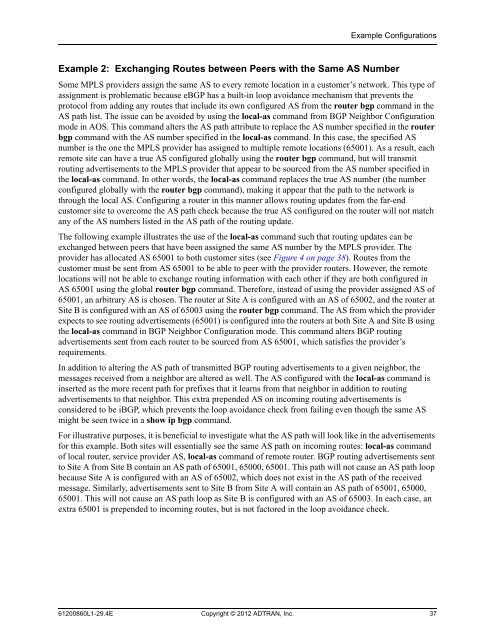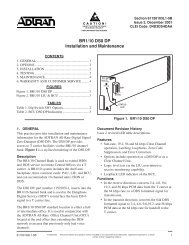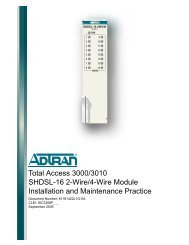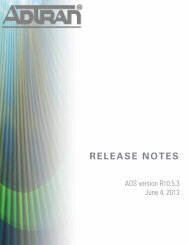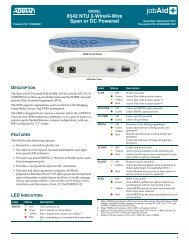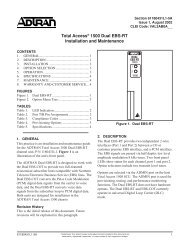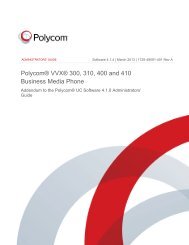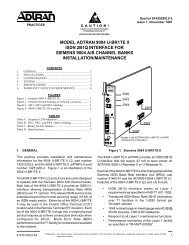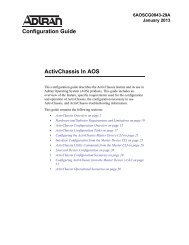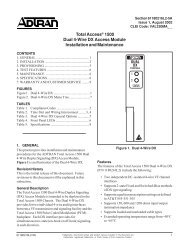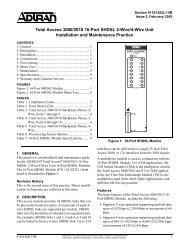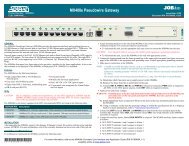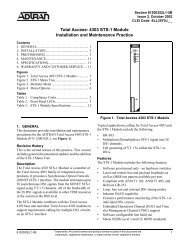View - ADTRAN Support Community
View - ADTRAN Support Community
View - ADTRAN Support Community
You also want an ePaper? Increase the reach of your titles
YUMPU automatically turns print PDFs into web optimized ePapers that Google loves.
Example Configurations<br />
Example 2: Exchanging Routes between Peers with the Same AS Number<br />
Some MPLS providers assign the same AS to every remote location in a customer’s network. This type of<br />
assignment is problematic because eBGP has a built-in loop avoidance mechanism that prevents the<br />
protocol from adding any routes that include its own configured AS from the router bgp command in the<br />
AS path list. The issue can be avoided by using the local-as command from BGP Neighbor Configuration<br />
mode in AOS. This command alters the AS path attribute to replace the AS number specified in the router<br />
bgp command with the AS number specified in the local-as command. In this case, the specified AS<br />
number is the one the MPLS provider has assigned to multiple remote locations (65001). As a result, each<br />
remote site can have a true AS configured globally using the router bgp command, but will transmit<br />
routing advertisements to the MPLS provider that appear to be sourced from the AS number specified in<br />
the local-as command. In other words, the local-as command replaces the true AS number (the number<br />
configured globally with the router bgp command), making it appear that the path to the network is<br />
through the local AS. Configuring a router in this manner allows routing updates from the far-end<br />
customer site to overcome the AS path check because the true AS configured on the router will not match<br />
any of the AS numbers listed in the AS path of the routing update.<br />
The following example illustrates the use of the local-as command such that routing updates can be<br />
exchanged between peers that have been assigned the same AS number by the MPLS provider. The<br />
provider has allocated AS 65001 to both customer sites (see Figure 4 on page 38). Routes from the<br />
customer must be sent from AS 65001 to be able to peer with the provider routers. However, the remote<br />
locations will not be able to exchange routing information with each other if they are both configured in<br />
AS 65001 using the global router bgp command. Therefore, instead of using the provider assigned AS of<br />
65001, an arbitrary AS is chosen. The router at Site A is configured with an AS of 65002, and the router at<br />
Site B is configured with an AS of 65003 using the router bgp command. The AS from which the provider<br />
expects to see routing advertisements (65001) is configured into the routers at both Site A and Site B using<br />
the local-as command in BGP Neighbor Configuration mode. This command alters BGP routing<br />
advertisements sent from each router to be sourced from AS 65001, which satisfies the provider’s<br />
requirements.<br />
In addition to altering the AS path of transmitted BGP routing advertisements to a given neighbor, the<br />
messages received from a neighbor are altered as well. The AS configured with the local-as command is<br />
inserted as the more recent path for prefixes that it learns from that neighbor in addition to routing<br />
advertisements to that neighbor. This extra prepended AS on incoming routing advertisements is<br />
considered to be iBGP, which prevents the loop avoidance check from failing even though the same AS<br />
might be seen twice in a show ip bgp command.<br />
For illustrative purposes, it is beneficial to investigate what the AS path will look like in the advertisements<br />
for this example. Both sites will essentially see the same AS path on incoming routes: local-as command<br />
of local router, service provider AS, local-as command of remote router. BGP routing advertisements sent<br />
to Site A from Site B contain an AS path of 65001, 65000, 65001. This path will not cause an AS path loop<br />
because Site A is configured with an AS of 65002, which does not exist in the AS path of the received<br />
message. Similarly, advertisements sent to Site B from Site A will contain an AS path of 65001, 65000,<br />
65001. This will not cause an AS path loop as Site B is configured with an AS of 65003. In each case, an<br />
extra 65001 is prepended to incoming routes, but is not factored in the loop avoidance check.<br />
61200860L1-29.4E Copyright © 2012 <strong>ADTRAN</strong>, Inc. 37


